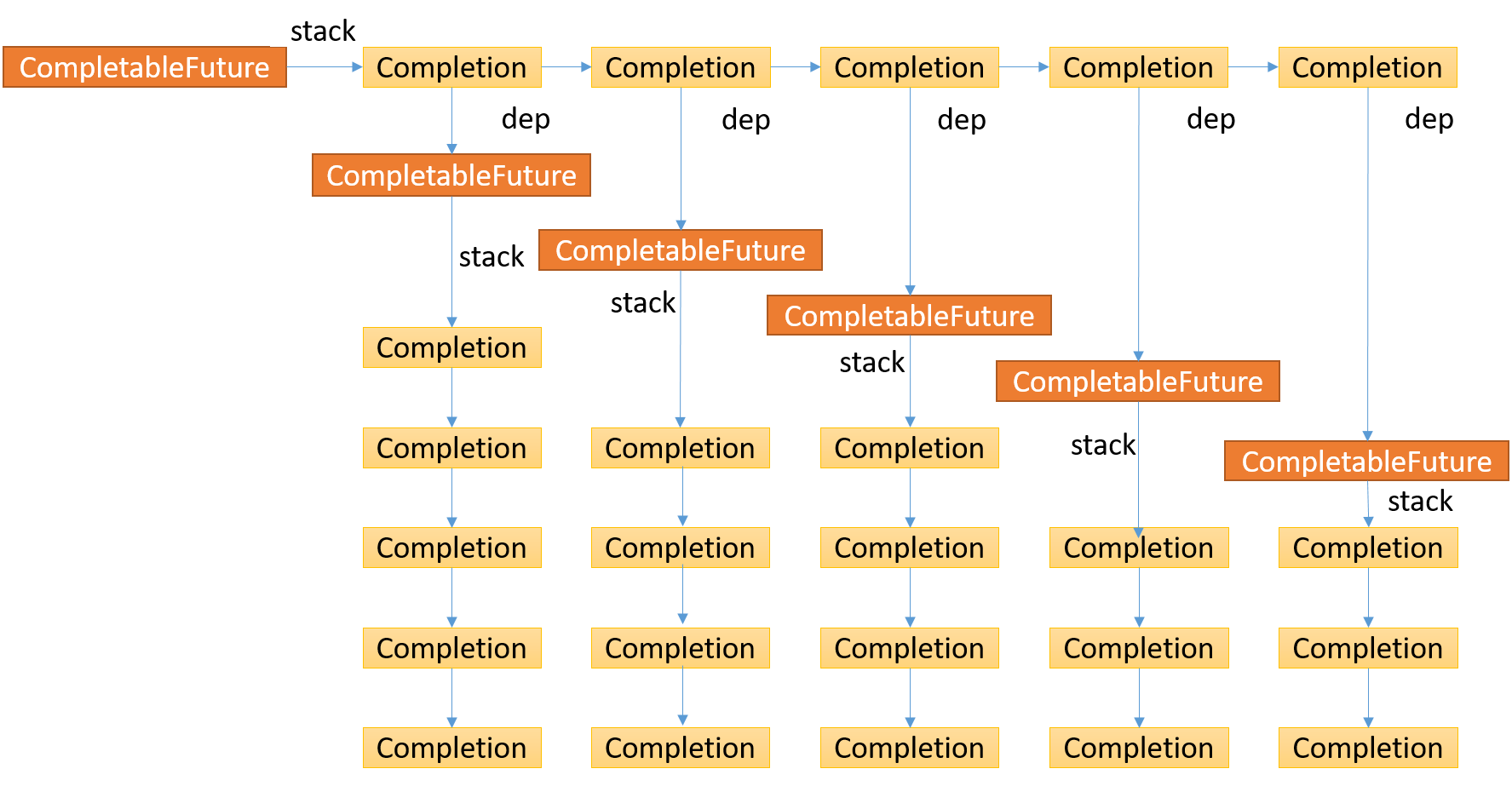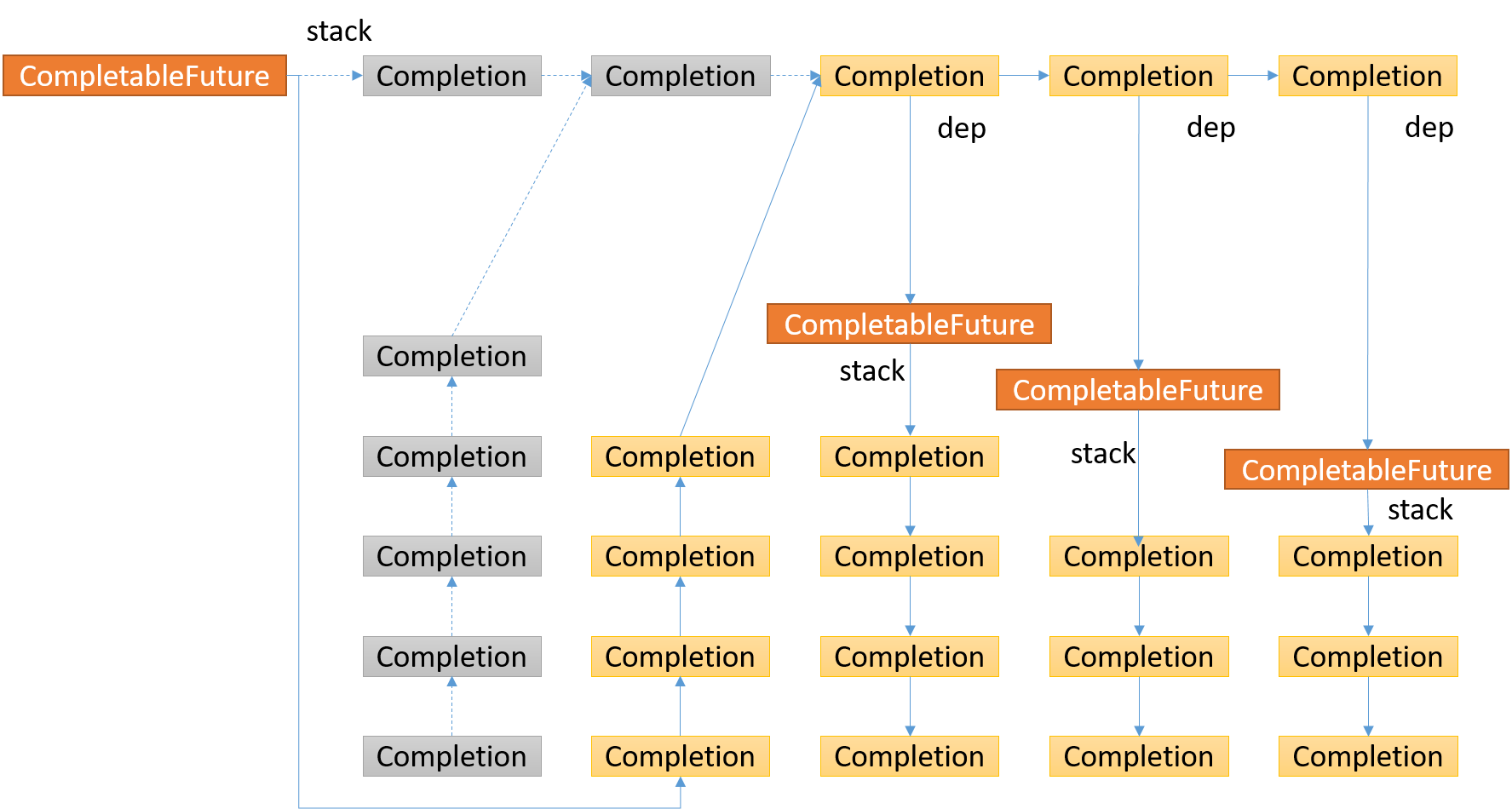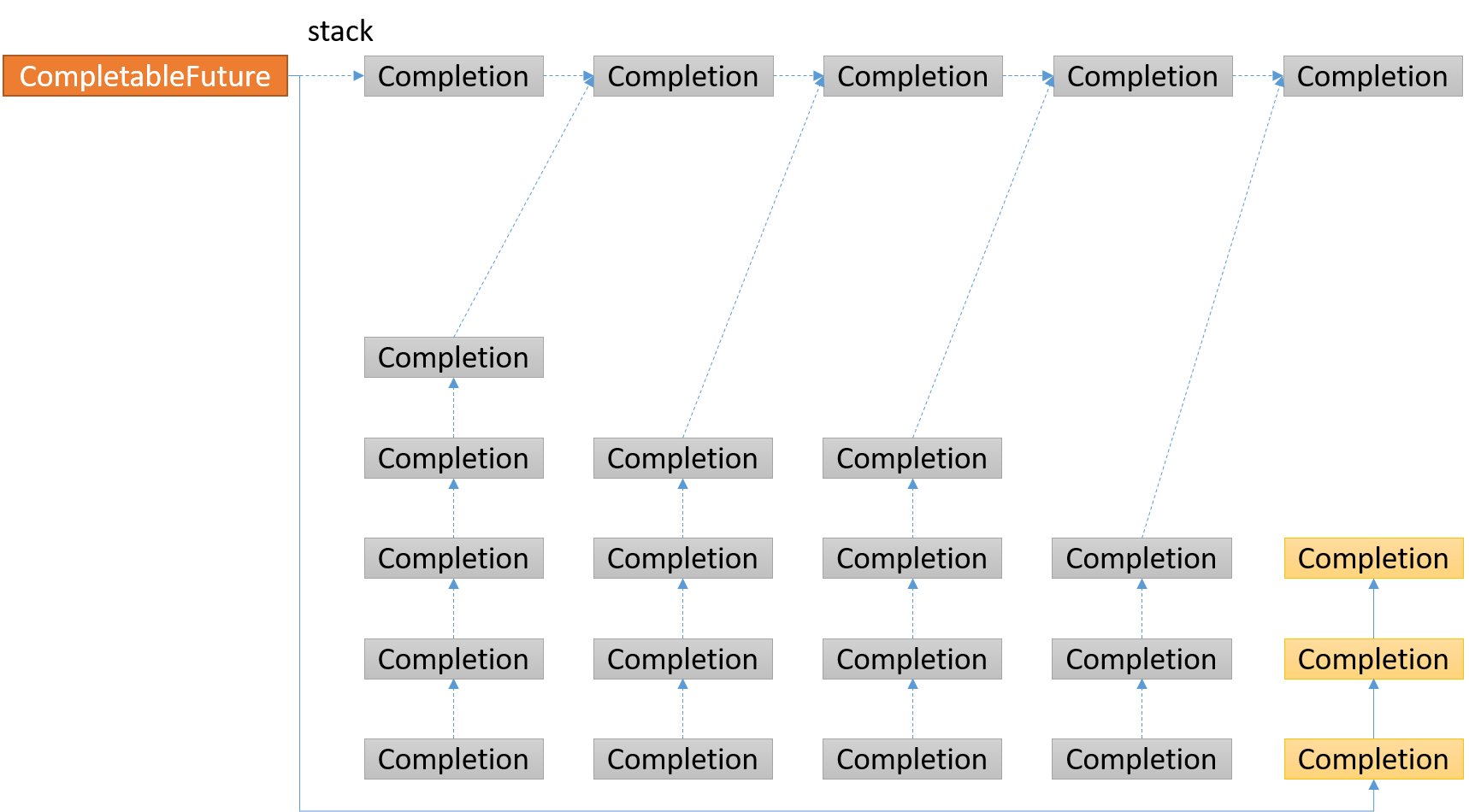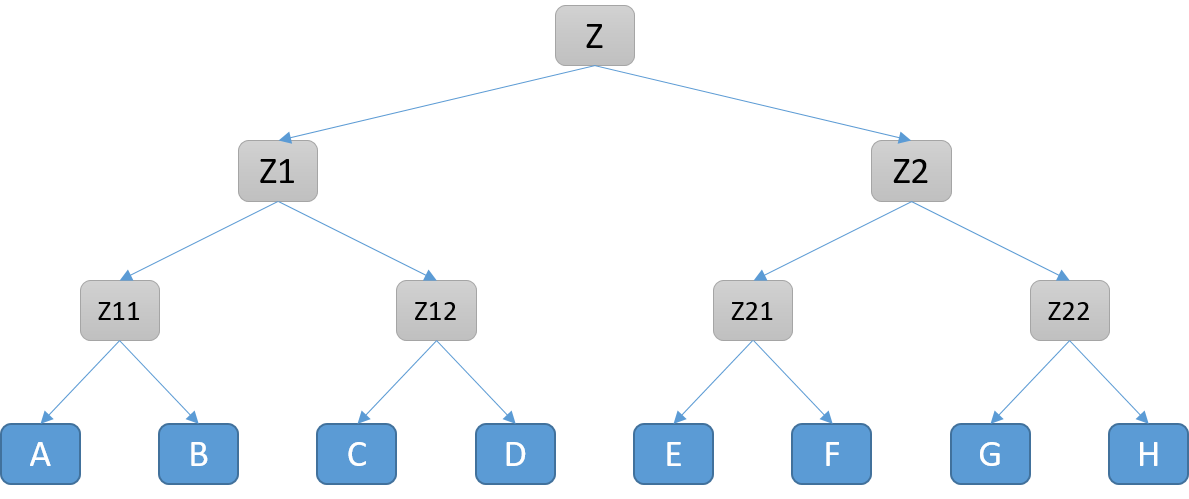簡介
先說Future, 它用來描述一個異步計算的結果。isDone方法可以用來檢查計算是否完成,get方法可以用來獲取結果,直到完成前一直阻塞當前線程,cancel方法可以取消任務。而對於結果的獲取,只能通過阻塞(get())或者輪詢的方式[while(!isDone)]. 阻塞的方式違背了異步編程的理念,輪詢的方式耗費無謂的CPU資源(CPU空轉)。於是,CompletableFuture應運而生。
樣例
後面介紹的源碼都會以下面的用例爲切入點,循着調用軌跡理解源碼。如果任務很耗時,記得傳Executor, 或者方法末尾加上future.get(); 因爲CompletableFuture默認使用ForkJoinPool, 而ForkJoinPool裏面的線程都是daemon線程,主線程跑完了,虛擬機也就over了。
1 public void whenComplete() { 2 CompletableFuture<Integer> future = CompletableFuture.supplyAsync(() -> 100); 3 future.whenComplete((l, r) -> System.out.println(l)); 4 } 5 6 public void thenApply() { 7 CompletableFuture<Integer> future = CompletableFuture.supplyAsync(() -> 100); 8 future.thenApply(i -> -i); 9 }10 11 public void thenAccept() {12 CompletableFuture<Integer> future = CompletableFuture.supplyAsync(() -> 100);13 future.thenAccept(System.out::println);14 }15 16 public void thenRun() {17 CompletableFuture<Integer> future = CompletableFuture.supplyAsync(() -> 100);18 future.thenRun(() -> System.out.println("Done"));19 }20 21 public void thenAcceptBoth() {22 CompletableFuture<Integer> future = CompletableFuture.supplyAsync(() -> 100);23 CompletableFuture<Integer> other = CompletableFuture.supplyAsync(() -> 200);24 future.thenAcceptBoth(other, (x, y) -> System.out.println(x + y));25 }26 27 public void acceptEither() {28 CompletableFuture<Integer> future = CompletableFuture.supplyAsync(() -> 100);29 CompletableFuture<Integer> other = CompletableFuture.supplyAsync(() -> 200);30 future.acceptEither(other, System.out::println);31 32 }33 34 public void allOf() {35 CompletableFuture<Integer> future = CompletableFuture.supplyAsync(() -> 100);36 CompletableFuture<Integer> second = CompletableFuture.supplyAsync(() -> 200);37 CompletableFuture<Integer> third = CompletableFuture.supplyAsync(() -> 300);38 CompletableFuture.allOf(future, second, third);39 40 }41 42 public void anyOf() throws InterruptedException, ExecutionException {43 CompletableFuture<Integer> future = CompletableFuture.supplyAsync(() -> 100);44 CompletableFuture<Integer> second = CompletableFuture.supplyAsync(() -> 200);45 CompletableFuture<Integer> third = CompletableFuture.supplyAsync(() -> 300);46 CompletableFuture.anyOf(future, second, third);47 }
源碼分析
supplyAsync
supplyAsync(Supplier<U> supplier)
1 public static <U> CompletableFuture<U> supplyAsync(Supplier<U> supplier) {2 return asyncSupplyStage(asyncPool, supplier); // asyncPool, ForkJoinPool.commonPool()或者ThreadPerTaskExecutor(實現了Executor接口,裏面的內容是{new Thread(r).start();})3 }
asyncSupplyStage(Executor e, Supplier<U> f)
1 static <U> CompletableFuture<U> asyncSupplyStage(Executor e, Supplier<U> f) {2 if (f == null)3 throw new NullPointerException();4 CompletableFuture<U> d = new CompletableFuture<U>(); // 構建一個新的CompletableFuture, 以此構建AsyncSupply作爲Executor的執行參數5 e.execute(new AsyncSupply<U>(d, f)); // AsyncSupply繼承了ForkJoinTask, 實現了Runnable, AsynchronousCompletionTask接口6 return d; // 返回d,立返7 }
AsyncSupply
1 // CompletableFuture的靜態內部類,作爲一個ForkJoinTask 2 static final class AsyncSupply<T> extends ForkJoinTask<Void> implements Runnable, AsynchronousCompletionTask { 3 CompletableFuture<T> dep; // AsyncSupply作爲一個依賴Task,dep作爲這個Task的Future 4 Supplier<T> fn; // fn作爲這個Task的具體執行邏輯,函數式編程 5 6 AsyncSupply(CompletableFuture<T> dep, Supplier<T> fn) { 7 this.dep = dep; 8 this.fn = fn; 9 }10 11 public final Void getRawResult() {12 return null;13 }14 15 public final void setRawResult(Void v) {16 }17 18 public final boolean exec() {19 run();20 return true;21 }22 23 public void run() {24 CompletableFuture<T> d;25 Supplier<T> f;26 if ((d = dep) != null && (f = fn) != null) { // 非空判斷27 dep = null;28 fn = null;29 if (d.result == null) { // 查看任務是否結束,如果已經結束(result != null),直接調用postComplete()方法30 try {31 d.completeValue(f.get()); // 等待任務結束,並設置結果32 } catch (Throwable ex) {33 d.completeThrowable(ex); // 異常34 }35 }36 d.postComplete(); // 任務結束後,會執行所有依賴此任務的其他任務,這些任務以一個無鎖併發棧的形式存在37 }38 }39 }
postComplete()
1 final void postComplete() { 2 CompletableFuture<?> f = this; // 當前CompletableFuture 3 Completion h; // 無鎖併發棧,(Completion next), 保存的是依靠當前的CompletableFuture一串任務,完成即觸發(回調) 4 while ((h = f.stack) != null || (f != this && (h = (f = this).stack) != null)) { // 當f的stack爲空時,使f重新指向當前的CompletableFuture,繼續後面的結點 5 CompletableFuture<?> d; 6 Completion t; 7 if (f.casStack(h, t = h.next)) { // 從頭遍歷stack,並更新頭元素 8 if (t != null) { 9 if (f != this) { // 如果f不是當前CompletableFuture,則將它的頭結點壓入到當前CompletableFuture的stack中,使樹形結構變成鏈表結構,避免遞歸層次過深10 pushStack(h);11 continue; // 繼續下一個結點,批量壓入到當前棧中12 }13 h.next = null; // 如果是當前CompletableFuture, 解除頭節點與棧的聯繫14 }15 f = (d = h.tryFire(NESTED)) == null ? this : d; // 調用頭節點的tryFire()方法,該方法可看作Completion的鉤子方法,執行完邏輯後,會向後傳播的16 }17 }18 }
示意圖
每個CompletableFuture持有一個Completion棧stack, 每個Completion持有一個CompletableFuture -> dep, 如此遞歸循環下去,是層次很深的樹形結構,所以想辦法將其變成鏈表結構。
首先取出頭結點,下圖中灰色Completion結點,它會返回一個CompletableFuture, 同樣也擁有一個stack,策略是遍歷這個CompletableFuture的stack的每個結點,依次壓入到當前CompletableFuture的stack中,關係如下箭頭所示,灰色結點指的是處理過的結點。
第一個Completion結點返回的CompletableFuture, 將擁有的stack裏面的所有結點都壓入了當前CompletableFuture的stack裏面
後續的Completion結點返回的CompletableFuture, 將擁有的stack裏面的所有結點都壓入了當前CompletableFuture的stack裏面,重新構成了一個鏈表結構,後續也按照前面的邏輯操作,如此反覆,便會遍歷完所有的CompletableFuture, 這些CompletableFuture(葉子結點)的stack爲空,也是結束條件。
postComplete()最後調用的是Completion#tryFire()方法,先看下Completion的數據結構
Completion
1 abstract static class Completion extends ForkJoinTask<Void> implements Runnable, AsynchronousCompletionTask { 2 volatile Completion next; // 無鎖併發棧 3 4 /** 5 * 鉤子方法,有三種模式,postComplete()方法裏面使用的是NESTED模式,避免過深的遞歸調用 SYNC, ASYNC, or NESTED 6 */ 7 abstract CompletableFuture<?> tryFire(int mode); // run()和exec()都調用了這個鉤子方法 8 9 /** cleanStack()方法裏有用到 */10 abstract boolean isLive();11 12 public final void run() {13 tryFire(ASYNC);14 }15 16 public final boolean exec() {17 tryFire(ASYNC);18 return true;19 }20 21 public final Void getRawResult() {22 return null;23 }24 25 public final void setRawResult(Void v) {26 }27 }static final int SYNC = 0; 同步
static final int ASYNC = 1; 異步
static final int NESTED = -1; 嵌套
繼承了ForkJoinTask, 實現了Runnable, AsynchronousCompletionTask接口,它有諸多子類,如下圖
後面的方法都對應着不同的子類。
先看一個子類UniCompletion
1 abstract static class UniCompletion<T,V> extends Completion { 2 Executor executor; // 執行器 3 CompletableFuture<V> dep; // 依賴的任務 4 CompletableFuture<T> src; // 被依賴的任務 5 6 UniCompletion(Executor executor, CompletableFuture<V> dep, 7 CompletableFuture<T> src) { 8 this.executor = executor; this.dep = dep; this.src = src; 9 }10 11 final boolean claim() { // 如果當前任務可以被執行,返回true,否則,返回false; 保證任務只被執行一次12 Executor e = executor;13 if (compareAndSetForkJoinTaskTag((short)0, (short)1)) {14 if (e == null)15 return true;16 executor = null; // 設置爲不可用17 e.execute(this);18 }19 return false;20 }21 22 final boolean isLive() { return dep != null; }23 }claim()方法保證任務只被執行一次。
whenComplete
whenComplete()/whenCompleteAsync()
1 public CompletableFuture<T> whenComplete(BiConsumer<? super T, ? super Throwable> action) {2 return uniWhenCompleteStage(null, action);3 }4 5 public CompletableFuture<T> whenCompleteAsync(BiConsumer<? super T, ? super Throwable> action) {6 return uniWhenCompleteStage(asyncPool, action);7 }xxx和xxxAsync方法的區別是,有沒有asyncPool作爲入參,有的話,任務直接入參,不檢查任務是否完成。uniWhenCompleteStage方法有說明。
uniWhenCompleteStage(Executor e, BiConsumer<? super T, ? super Throwable> f)
1 private CompletableFuture<T> uniWhenCompleteStage(Executor e, BiConsumer<? super T, ? super Throwable> f) { 2 if (f == null) 3 throw new NullPointerException(); 4 CompletableFuture<T> d = new CompletableFuture<T>(); // 構建future 5 if (e != null || !d.uniWhenComplete(this, f, null)) { // 如果線程池不爲空,直接構建任務入棧,並調用tryFire()方法;否則,調用uniWhenComplete()方法,檢查依賴的那個任務是否完成,沒有完成返回false, 6 // 完成了返回true, 以及後續一些操作。 7 UniWhenComplete<T> c = new UniWhenComplete<T>(e, d, this, f); // UniWhenComplete繼承了UniCompletion 8 push(c); 9 c.tryFire(SYNC); // 先調一下鉤子方法,檢查一下任務是否結束10 }11 return d;12 }
uniWhenComplete(CompletableFuture<T> a, BiConsumer<? super T, ? super Throwable> f, UniWhenComplete<T> c)
1 final boolean uniWhenComplete(CompletableFuture<T> a, BiConsumer<? super T, ? super Throwable> f, UniWhenComplete<T> c) { 2 Object r; 3 T t; 4 Throwable x = null; 5 if (a == null || (r = a.result) == null || f == null) // 被依賴的任務還未完成 6 return false; 7 if (result == null) { // 被依賴的任務完成了 8 try { 9 if (c != null && !c.claim()) // 判斷任務是否能被執行10 return false;11 if (r instanceof AltResult) { // 判斷異常,AltResult類型很簡單,裏面只有一個屬性Throwable ex; 12 x = ((AltResult) r).ex;13 t = null;14 } else {15 @SuppressWarnings("unchecked")16 T tr = (T) r; // 正常的結果17 t = tr;18 }19 f.accept(t, x); // 執行任務20 if (x == null) {21 internalComplete(r); // 任務的結果設置爲被依賴任務的結果22 return true;23 }24 } catch (Throwable ex) {25 if (x == null)26 x = ex; // 記錄異常27 }28 completeThrowable(x, r); // 設置異常和結果29 }30 return true;31 }
push()
1 final void push(UniCompletion<?, ?> c) { 2 if (c != null) { 3 while (result == null && !tryPushStack(c)) 4 lazySetNext(c, null); // 失敗重置c的next域 5 } 6 } 7 8 final boolean tryPushStack(Completion c) { 9 Completion h = stack;10 lazySetNext(c, h);11 return UNSAFE.compareAndSwapObject(this, STACK, h, c);12 }13 14 static void lazySetNext(Completion c, Completion next) {15 UNSAFE.putOrderedObject(c, NEXT, next);16 }
UniWhenComplete
1 static final class UniWhenComplete<T> extends UniCompletion<T, T> { 2 BiConsumer<? super T, ? super Throwable> fn; 3 4 UniWhenComplete(Executor executor, CompletableFuture<T> dep, CompletableFuture<T> src, 5 BiConsumer<? super T, ? super Throwable> fn) { 6 super(executor, dep, src); 7 this.fn = fn; 8 } 9 10 final CompletableFuture<T> tryFire(int mode) { // 鉤子方法11 CompletableFuture<T> d; // 依賴的任務12 CompletableFuture<T> a; // 被依賴的任務13 if ((d = dep) == null || !d.uniWhenComplete(a = src, fn, mode > 0 ? null : this)) // 如果是異步模式(mode = 1),就不判斷任務是否結束14 return null; // dep爲空,說明已經調用過了15 dep = null;16 src = null;17 fn = null;18 return d.postFire(a, mode); // 鉤子方法之後的處理19 }20 }
postFire(CompletableFuture<?> a, int mode)
1 final CompletableFuture<T> postFire(CompletableFuture<?> a, int mode) { 2 if (a != null && a.stack != null) { // 被依賴的任務存在,且stack不爲空,先處理它 3 if (mode < 0 || a.result == null) // 如果是嵌套模式(mode = -1), 或者任務的結果爲空,直接清空棧 4 a.cleanStack(); 5 else 6 a.postComplete(); // 否則,調用postComplete()方法 7 } 8 if (result != null && stack != null) { // 再處理當前任務 9 if (mode < 0) // 嵌套模式,直接返回自身(樹 -> 鏈表,避免過深的遞歸調用)10 return this;11 else12 postComplete(); // 調用postComplete()方法13 }14 return null;15 }
cleanStack()
1 final void cleanStack() { // 過濾掉已經死掉的結點(Not isLive) 2 for (Completion p = null, q = stack; q != null;) { // q指針從頭節點開始,向右移動,s一直執行q的下一個結點,p要麼爲空,要麼指向遍歷過的最後一個活着的結點,一旦發現q死掉了,就斷開q, 連接p, s 3 Completion s = q.next; 4 if (q.isLive()) { // 還活着,p指向遍歷過的最後一個結點,q向右移動 5 p = q; 6 q = s; 7 } else if (p == null) { // 說明第一個結點就是死掉的,cas stack, q指向stack 8 casStack(q, s); 9 q = stack;10 } else { // 否則的話,連接p, s11 p.next = s;12 if (p.isLive()) // 再次判斷p結點是否還或者(在這期間是否有別的線程改動了)13 q = s; // 還活着,q繼續向右移動14 else {15 p = null; // 過期的值,從新開始16 q = stack;17 }18 }19 }20 }
如下圖
1. 第1個結點是無效結點,更新stack,更新指針
2. 第2個結點是有效結點,更新指針
3. 第3個結點是無效結點,更新指針
4. 第4個結點是有效結點,更新指針
thenApply
1 public <U> CompletableFuture<U> thenApply(Function<? super T, ? extends U> fn) { 2 return uniApplyStage(null, fn); 3 } 4 5 public <U> CompletableFuture<U> thenApplyAsync(Function<? super T, ? extends U> fn) { 6 return uniApplyStage(asyncPool, fn); 7 } 8 9 private <V> CompletableFuture<V> uniApplyStage(Executor e, Function<? super T, ? extends V> f) {10 if (f == null)11 throw new NullPointerException();12 CompletableFuture<V> d = new CompletableFuture<V>();13 if (e != null || !d.uniApply(this, f, null)) {14 UniApply<T, V> c = new UniApply<T, V>(e, d, this, f);15 push(c);16 c.tryFire(SYNC);17 }18 return d;19 }20 21 final <S> boolean uniApply(CompletableFuture<S> a, Function<? super S, ? extends T> f, UniApply<S, T> c) {22 Object r;23 Throwable x;24 if (a == null || (r = a.result) == null || f == null)25 return false;26 tryComplete: if (result == null) {27 if (r instanceof AltResult) {28 if ((x = ((AltResult) r).ex) != null) {29 completeThrowable(x, r); // 有異常,直接跳出30 break tryComplete;31 }32 r = null;33 }34 try {35 if (c != null && !c.claim())36 return false;37 @SuppressWarnings("unchecked")38 S s = (S) r;39 completeValue(f.apply(s));40 } catch (Throwable ex) {41 completeThrowable(ex);42 }43 }44 return true;45 }46 47 static final class UniApply<T, V> extends UniCompletion<T, V> {48 Function<? super T, ? extends V> fn;49 50 UniApply(Executor executor, CompletableFuture<V> dep, CompletableFuture<T> src,51 Function<? super T, ? extends V> fn) {52 super(executor, dep, src);53 this.fn = fn;54 }55 56 final CompletableFuture<V> tryFire(int mode) {57 CompletableFuture<V> d;58 CompletableFuture<T> a;59 if ((d = dep) == null || !d.uniApply(a = src, fn, mode > 0 ? null : this))60 return null;61 dep = null;62 src = null;63 fn = null;64 return d.postFire(a, mode);65 }66 }一樣的套路,thenApply/thenApplyAsync -> uniApplyStage -> uniApply -> tryFire -> postFire
thenAccept
1 public CompletableFuture<Void> thenAccept(Consumer<? super T> action) { 2 return uniAcceptStage(null, action); 3 } 4 5 public CompletableFuture<Void> thenAcceptAsync(Consumer<? super T> action) { 6 return uniAcceptStage(asyncPool, action); 7 } 8 9 private CompletableFuture<Void> uniAcceptStage(Executor e, Consumer<? super T> f) {10 if (f == null)11 throw new NullPointerException();12 CompletableFuture<Void> d = new CompletableFuture<Void>();13 if (e != null || !d.uniAccept(this, f, null)) {14 UniAccept<T> c = new UniAccept<T>(e, d, this, f);15 push(c);16 c.tryFire(SYNC);17 }18 return d;19 }20 21 final <S> boolean uniAccept(CompletableFuture<S> a, Consumer<? super S> f, UniAccept<S> c) {22 Object r;23 Throwable x;24 if (a == null || (r = a.result) == null || f == null)25 return false;26 tryComplete: if (result == null) {27 if (r instanceof AltResult) {28 if ((x = ((AltResult) r).ex) != null) {29 completeThrowable(x, r); // 有異常直接跳出30 break tryComplete;31 }32 r = null;33 }34 try {35 if (c != null && !c.claim())36 return false;37 @SuppressWarnings("unchecked")38 S s = (S) r;39 f.accept(s);40 completeNull();41 } catch (Throwable ex) {42 completeThrowable(ex);43 }44 }45 return true;46 }47 48 static final class UniAccept<T> extends UniCompletion<T, Void> {49 Consumer<? super T> fn;50 51 UniAccept(Executor executor, CompletableFuture<Void> dep, CompletableFuture<T> src, Consumer<? super T> fn) {52 super(executor, dep, src);53 this.fn = fn;54 }55 56 final CompletableFuture<Void> tryFire(int mode) {57 CompletableFuture<Void> d;58 CompletableFuture<T> a;59 if ((d = dep) == null || !d.uniAccept(a = src, fn, mode > 0 ? null : this))60 return null;61 dep = null;62 src = null;63 fn = null;64 return d.postFire(a, mode);65 }66 }thenAccept/thenAcceptAsync -> uniAcceptStage -> uniAccept -> tryFire -> postFire
thenRun
1 public CompletableFuture<Void> thenRun(Runnable action) { 2 return uniRunStage(null, action); 3 } 4 5 public CompletableFuture<Void> thenRunAsync(Runnable action) { 6 return uniRunStage(asyncPool, action); 7 } 8 9 private CompletableFuture<Void> uniRunStage(Executor e, Runnable f) {10 if (f == null)11 throw new NullPointerException();12 CompletableFuture<Void> d = new CompletableFuture<Void>();13 if (e != null || !d.uniRun(this, f, null)) {14 UniRun<T> c = new UniRun<T>(e, d, this, f);15 push(c);16 c.tryFire(SYNC);17 }18 return d;19 }20 21 final boolean uniRun(CompletableFuture<?> a, Runnable f, UniRun<?> c) {22 Object r;23 Throwable x;24 if (a == null || (r = a.result) == null || f == null)25 return false;26 if (result == null) {27 if (r instanceof AltResult && (x = ((AltResult) r).ex) != null)28 completeThrowable(x, r);29 else30 try {31 if (c != null && !c.claim())32 return false;33 f.run();34 completeNull();35 } catch (Throwable ex) {36 completeThrowable(ex);37 }38 }39 return true;40 }41 42 static final class UniRun<T> extends UniCompletion<T, Void> {43 Runnable fn;44 45 UniRun(Executor executor, CompletableFuture<Void> dep, CompletableFuture<T> src, Runnable fn) {46 super(executor, dep, src);47 this.fn = fn;48 }49 50 final CompletableFuture<Void> tryFire(int mode) {51 CompletableFuture<Void> d;52 CompletableFuture<T> a;53 if ((d = dep) == null || !d.uniRun(a = src, fn, mode > 0 ? null : this))54 return null;55 dep = null;56 src = null;57 fn = null;58 return d.postFire(a, mode);59 }60 }thenRun/thenRunAsync -> uniRunStage -> uniRun -> tryFire -> postFire
thenAcceptBoth
thenAcceptBoth
public <U> CompletableFuture<Void> thenAcceptBoth(CompletionStage<? extends U> other,
BiConsumer<? super T, ? super U> action) { return biAcceptStage(null, other, action);
} public <U> CompletableFuture<Void> thenAcceptBothAsync(CompletionStage<? extends U> other,
BiConsumer<? super T, ? super U> action) { return biAcceptStage(asyncPool, other, action);
}
biAcceptStage
private <U> CompletableFuture<Void> biAcceptStage(Executor e, CompletionStage<U> o,
BiConsumer<? super T, ? super U> f) {
CompletableFuture<U> b; if (f == null || (b = o.toCompletableFuture()) == null) throw new NullPointerException();
CompletableFuture<Void> d = new CompletableFuture<Void>(); if (e != null || !d.biAccept(this, b, f, null)) {
BiAccept<T, U> c = new BiAccept<T, U>(e, d, this, b, f);
bipush(b, c);
c.tryFire(SYNC);
} return d;
}
bipush
1 final void bipush(CompletableFuture<?> b, BiCompletion<?, ?, ?> c) { 2 if (c != null) { 3 Object r; 4 while ((r = result) == null && !tryPushStack(c)) // a的result還沒準備好,c壓入棧 5 lazySetNext(c, null); // 失敗重置c的next域 6 if (b != null && b != this && b.result == null) { // b的result也還沒準備好 7 Completion q = (r != null) ? c : new CoCompletion(c); // 根據a的result決定是否構建CoCompletion, 如果a未結束,則構建一個CoCompletion, CoCompletion最後調用的也是BiCompletion的tryFire 8 while (b.result == null && !b.tryPushStack(q)) // 將q壓入棧 9 lazySetNext(q, null); // 失敗重置q的next域10 }11 }12 }
CoCompletion
1 static final class CoCompletion extends Completion { 2 BiCompletion<?, ?, ?> base; 3 4 CoCompletion(BiCompletion<?, ?, ?> base) { 5 this.base = base; 6 } 7 8 final CompletableFuture<?> tryFire(int mode) { 9 BiCompletion<?, ?, ?> c;10 CompletableFuture<?> d;11 if ((c = base) == null || (d = c.tryFire(mode)) == null) // 調用的還是BiCompletion的tryFire方法12 return null;13 base = null;14 return d;15 }16 17 final boolean isLive() {18 BiCompletion<?, ?, ?> c;19 return (c = base) != null && c.dep != null;20 }21 }
biAccept
1 final <R, S> boolean biAccept(CompletableFuture<R> a, CompletableFuture<S> b, BiConsumer<? super R, ? super S> f, 2 BiAccept<R, S> c) { 3 Object r, s; 4 Throwable x; 5 if (a == null || (r = a.result) == null || b == null || (s = b.result) == null || f == null) 6 return false; // a和b都完成了,纔會往下走 7 tryComplete: if (result == null) { 8 if (r instanceof AltResult) { 9 if ((x = ((AltResult) r).ex) != null) { // a的異常檢查10 completeThrowable(x, r);11 break tryComplete;12 }13 r = null;14 }15 if (s instanceof AltResult) {16 if ((x = ((AltResult) s).ex) != null) { // b的異常檢查17 completeThrowable(x, s);18 break tryComplete;19 }20 s = null;21 }22 try {23 if (c != null && !c.claim())24 return false;25 @SuppressWarnings("unchecked")26 R rr = (R) r;27 @SuppressWarnings("unchecked")28 S ss = (S) s;29 f.accept(rr, ss); // 執行任務30 completeNull();31 } catch (Throwable ex) {32 completeThrowable(ex);33 }34 }35 return true;36 }
BiAccept
1 static final class BiAccept<T, U> extends BiCompletion<T, U, Void> { 2 BiConsumer<? super T, ? super U> fn; 3 4 BiAccept(Executor executor, CompletableFuture<Void> dep, CompletableFuture<T> src, CompletableFuture<U> snd, 5 BiConsumer<? super T, ? super U> fn) { 6 super(executor, dep, src, snd); 7 this.fn = fn; 8 } 9 10 final CompletableFuture<Void> tryFire(int mode) {11 CompletableFuture<Void> d;12 CompletableFuture<T> a;13 CompletableFuture<U> b;14 if ((d = dep) == null || !d.biAccept(a = src, b = snd, fn, mode > 0 ? null : this))15 return null;16 dep = null;17 src = null;18 snd = null;19 fn = null;20 return d.postFire(a, b, mode);21 }22 }23 24 abstract static class BiCompletion<T, U, V> extends UniCompletion<T, V> {25 CompletableFuture<U> snd; // second source for action26 27 BiCompletion(Executor executor, CompletableFuture<V> dep, CompletableFuture<T> src, CompletableFuture<U> snd) {28 super(executor, dep, src);29 this.snd = snd;30 }31 }thenAcceptBoth/thenAcceptBothAsync -> biAcceptStage -> biAccept -> tryFire -> postFire
acceptEither
1 public CompletableFuture<Void> acceptEither(CompletionStage<? extends T> other, Consumer<? super T> action) { 2 return orAcceptStage(null, other, action); 3 } 4 5 public CompletableFuture<Void> acceptEitherAsync(CompletionStage<? extends T> other, Consumer<? super T> action) { 6 return orAcceptStage(asyncPool, other, action); 7 } 8 9 private <U extends T> CompletableFuture<Void> orAcceptStage(Executor e, CompletionStage<U> o,10 Consumer<? super T> f) {11 CompletableFuture<U> b;12 if (f == null || (b = o.toCompletableFuture()) == null)13 throw new NullPointerException();14 CompletableFuture<Void> d = new CompletableFuture<Void>();15 if (e != null || !d.orAccept(this, b, f, null)) {16 OrAccept<T, U> c = new OrAccept<T, U>(e, d, this, b, f);17 orpush(b, c);18 c.tryFire(SYNC);19 }20 return d;21 }22 23 final <R, S extends R> boolean orAccept(CompletableFuture<R> a, CompletableFuture<S> b, Consumer<? super R> f,24 OrAccept<R, S> c) {25 Object r;26 Throwable x;27 if (a == null || b == null || ((r = a.result) == null && (r = b.result) == null) || f == null)28 return false; // a和b有一個完成了就往下走29 tryComplete: if (result == null) {30 try {31 if (c != null && !c.claim())32 return false;33 if (r instanceof AltResult) { // 異常34 if ((x = ((AltResult) r).ex) != null) {35 completeThrowable(x, r);36 break tryComplete;37 }38 r = null;39 }40 @SuppressWarnings("unchecked")41 R rr = (R) r;42 f.accept(rr); // 執行43 completeNull();44 } catch (Throwable ex) {45 completeThrowable(ex);46 }47 }48 return true;49 }50 51 static final class OrAccept<T, U extends T> extends BiCompletion<T, U, Void> {52 Consumer<? super T> fn;53 54 OrAccept(Executor executor, CompletableFuture<Void> dep, CompletableFuture<T> src, CompletableFuture<U> snd,55 Consumer<? super T> fn) {56 super(executor, dep, src, snd);57 this.fn = fn;58 }59 60 final CompletableFuture<Void> tryFire(int mode) {61 CompletableFuture<Void> d;62 CompletableFuture<T> a;63 CompletableFuture<U> b;64 if ((d = dep) == null || !d.orAccept(a = src, b = snd, fn, mode > 0 ? null : this))65 return null;66 dep = null;67 src = null;68 snd = null;69 fn = null;70 return d.postFire(a, b, mode);71 }72 }73 74 final void orpush(CompletableFuture<?> b, BiCompletion<?, ?, ?> c) {75 if (c != null) {76 while ((b == null || b.result == null) && result == null) { // a和b的result都沒好,纔會考慮入棧77 if (tryPushStack(c)) { // 先入a的棧78 if (b != null && b != this && b.result == null) { // 入a的棧成功,b的result還沒好79 Completion q = new CoCompletion(c); // a還未結束,用c構建CoCompletion80 while (result == null && b.result == null && !b.tryPushStack(q)) // 再次判斷,a和b的result都沒好,纔會考慮入棧81 lazySetNext(q, null); // 失敗置空q的next域82 }83 break;84 }85 lazySetNext(c, null); // 失敗置空c的next域86 }87 }88 }acceptEither/acceptEitherAsync -> orAcceptStage -> orAccept -> tryFire -> postFire
allOf
1 public static CompletableFuture<Void> allOf(CompletableFuture<?>... cfs) { 2 return andTree(cfs, 0, cfs.length - 1); 3 } 4 5 static CompletableFuture<Void> andTree(CompletableFuture<?>[] cfs, int lo, int hi) { // 將一個數組構建成一棵樹,二叉樹,動態規劃 6 CompletableFuture<Void> d = new CompletableFuture<Void>(); 7 if (lo > hi) // empty 8 d.result = NIL; 9 else {10 CompletableFuture<?> a, b;11 int mid = (lo + hi) >>> 1;12 if ((a = (lo == mid ? cfs[lo] : andTree(cfs, lo, mid))) == null13 || (b = (lo == hi ? a : (hi == mid + 1) ? cfs[hi] : andTree(cfs, mid + 1, hi))) == null)14 throw new NullPointerException();15 if (!d.biRelay(a, b)) {16 BiRelay<?, ?> c = new BiRelay<>(d, a, b);17 a.bipush(b, c); // both18 c.tryFire(SYNC);19 }20 }21 return d;22 }23 24 static final class BiRelay<T, U> extends BiCompletion<T, U, Void> { // for And25 BiRelay(CompletableFuture<Void> dep, CompletableFuture<T> src, CompletableFuture<U> snd) {26 super(null, dep, src, snd);27 }28 29 final CompletableFuture<Void> tryFire(int mode) {30 CompletableFuture<Void> d;31 CompletableFuture<T> a;32 CompletableFuture<U> b;33 if ((d = dep) == null || !d.biRelay(a = src, b = snd))34 return null;35 src = null;36 snd = null;37 dep = null;38 return d.postFire(a, b, mode);39 }40 }41 42 boolean biRelay(CompletableFuture<?> a, CompletableFuture<?> b) {43 Object r, s;44 Throwable x;45 if (a == null || (r = a.result) == null || b == null || (s = b.result) == null)46 return false; // a和b都結束了才往下執行47 if (result == null) {48 if (r instanceof AltResult && (x = ((AltResult) r).ex) != null)49 completeThrowable(x, r);50 else if (s instanceof AltResult && (x = ((AltResult) s).ex) != null)51 completeThrowable(x, s);52 else53 completeNull(); // 輔助結點,什麼都不做54 }55 return true;56 }allOf -> andTree -> biRelay -> tryFire -> postFire
anyOf
1 public static CompletableFuture<Object> anyOf(CompletableFuture<?>... cfs) { 2 return orTree(cfs, 0, cfs.length - 1); 3 } 4 5 static CompletableFuture<Object> orTree(CompletableFuture<?>[] cfs, int lo, int hi) { // 將一個數組構建成一棵樹,二叉樹,動態規劃 6 CompletableFuture<Object> d = new CompletableFuture<Object>(); 7 if (lo <= hi) { 8 CompletableFuture<?> a, b; 9 int mid = (lo + hi) >>> 1;10 if ((a = (lo == mid ? cfs[lo] : orTree(cfs, lo, mid))) == null11 || (b = (lo == hi ? a : (hi == mid + 1) ? cfs[hi] : orTree(cfs, mid + 1, hi))) == null)12 throw new NullPointerException();13 if (!d.orRelay(a, b)) {14 OrRelay<?, ?> c = new OrRelay<>(d, a, b);15 a.orpush(b, c);16 c.tryFire(SYNC);17 }18 }19 return d;20 }21 22 static final class OrRelay<T, U> extends BiCompletion<T, U, Object> { // for Or23 OrRelay(CompletableFuture<Object> dep, CompletableFuture<T> src, CompletableFuture<U> snd) {24 super(null, dep, src, snd);25 }26 27 final CompletableFuture<Object> tryFire(int mode) {28 CompletableFuture<Object> d;29 CompletableFuture<T> a;30 CompletableFuture<U> b;31 if ((d = dep) == null || !d.orRelay(a = src, b = snd))32 return null;33 src = null;34 snd = null;35 dep = null;36 return d.postFire(a, b, mode);37 }38 }39 40 final boolean orRelay(CompletableFuture<?> a, CompletableFuture<?> b) {41 Object r;42 if (a == null || b == null || ((r = a.result) == null && (r = b.result) == null))43 return false; // a和b有一個結束就往下進行44 if (result == null)45 completeRelay(r);46 return true;47 }anyOf -> orTree -> orRelay -> tryFire -> postFire
數組構建樹
allOf和anyOf都用到了數組構建成樹的策略。
假設有一個任務Z(虛擬的,什麼都不做),依賴一組任務[A, B, C, D, E, F, G, H]
對於allOf, 當這組任務都完成時,纔會執行Z;對於anyOf, 當這組任務中有任何一個完成,就執行任務Z。
如果這組任務是數組結構或者鏈表結構,我們該如何解決呢?遍歷數組或者是鏈表,當任務都完成或者有一個完成時,就執行Z,需要不停地遍歷,這是輪詢的方法,不合適。
整個基調是回調,是指,當一個任務完成時,會接着執行所有依賴於它的任務。
作爲一個數組或者鏈表,該如何應用回調呢?誰在先,誰在後呢?因爲不知道哪個任務會先完成,所以沒法確定次序。而且這組任務之間也不應該相互依賴,它們只不過都是被Z依賴。
如果這組任務只有一個的話,那就演變成了X.thenXXX(Z), 如果這組任務有兩個的話,allOf -> Both,anyOf -> Either
如果Z依賴Z1,Z2兩個個任務,Z1和Z2依賴Z11,Z12和Z21,Z22四個任務,依次類推,當虛擬的任務的個數達到真實任務的個數的一半時,就讓虛擬任務監聽真實的任務,動態規劃加二叉樹,時間複雜度也只是logn級別的。
1 static String array2Tree(String[] cfs, int lo, int hi) { 2 String d = new String(cfs[lo] + cfs[hi]); 3 if (lo <= hi) { 4 String a, b; 5 int mid = (lo + hi) >>> 1; // 二分 6 if (lo == mid) { // a作爲左半部分的的結果 7 a = cfs[lo]; // 當只有不超過兩個元素時,a直接取第一個值 8 } else { 9 a = array2Tree(cfs, lo, mid);10 }11 if (lo == hi) { // 當只有一個元素的時候,b取a的值12 b = a;13 } else {14 if (hi == mid + 1) { // 右半部分只有兩個元素時,b取第二個元素的值15 b = cfs[hi];16 } else {17 b = array2Tree(cfs, mid + 1, hi);18 }19 }20 if (a == null || b == null) {21 throw new NullPointerException();22 }23 System.out.println("[" + a + "][" + b + "]->[" + d + "]");24 }25 return d;26 }
Console
[A][B]->[AB] [C][D]->[CD] [AB][CD]->[AD] [E][F]->[EF] [G][H]->[GH] [EF][GH]->[EH] [AD][EH]->[AH]
如下圖
對於allOf, Z只要保證Z1和Z2都完成了就行,Z1和Z2分別保證Z11,Z12 和 Z21,Z22都完成了就像,而Z11,Z12,Z21,Z22則分別保證了A-H任務都完成。
對應anyOf, Z 只要保證Z1和Z2有一個完成了就像,Z1和Z2聯合保證了Z11,Z12,Z21,Z22這4個任務只要有一個完成了就行,同理,Z11,Z12,Z21,Z22則聯合保證了A-H中有一個任務完成了就行。
然後,Z就可以執行了,其實Z什麼也沒做,只是從這組任務裏得出一個結果。
行文至此結束。
尊重他人的勞動,轉載請註明出處:http://www.cnblogs.com/aniao/p/aniao_cf.html












